In order for the hike to be successful, novice tourists should learn how to tie basic rope knots, master their names and patterns. It is important to use the fastenings for their intended purpose, this will help to avoid tragic troubles along the way.
Ropes of the same thickness
Tourist knots with names (diagrams and descriptions of how to tie from ropes of equal diameter are discussed below) help tourists on a hike. If it is necessary to tie 2 cords of the same thickness, tourists use special types of bundles created on the basis of sea knots.
Straight knot
The straight knot is called the Hercules knot. Since ancient times it has been used when it is necessary to connect a broken rope, extend a cable or pack a light load.
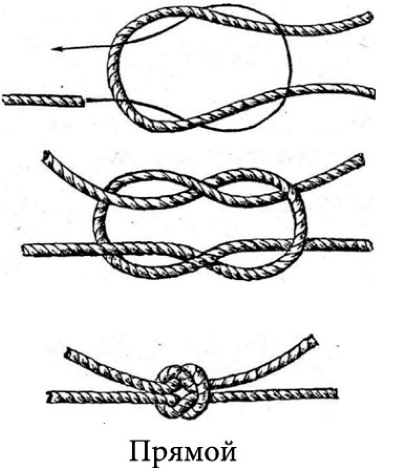
Technique of execution:
- They take a rope in each hand.
- The ends of the right and left ropes are intertwined once.
- An open loop is formed from the free end of the top rope.
- The end of the bottom rope is pulled through this loop, repeating the bottom weave in a mirror image. This results in a symmetrical bundle of 2 loops.
- The knot is straightened and tightened by pulling the ropes in different directions.
A correct straight knot has short ends parallel to long ones and are opposite each other. If they stick out in different directions, the connection is made with errors and will untie under load.
Properties of the direct node
| Positive | Negative | Features of use |
| Easy to execute | Shrinks significantly when loaded and wet. | A stick or carabiner is inserted into the knot to make it easier to untie, except in situations where it is important to maintain tension on the rope or the knot needs to be pulled through another carabiner. |
| Can be quickly unraveled if necessary | Do not use on wet, icy or synthetic ropes. | Control nodes required. |
| Creeps under heavy loads. | Not used in mountaineering or belay connections. |
The main requirement for the knot is to use ropes of the same thickness and to perform it correctly., otherwise it will untie itself. Sailors know that incorrect tying of the Hercules knot has led to human casualties more than once.
Reef
In situations where you need to tie something tightly and then quickly untie it, use a reef knot. Sailors use this knot to tie lifeboat covers, sails, and deck machinery. In tourism, a reef knot is used to connect auxiliary ropes that are subject to variable loads. The popular name for this knot is a knot with 1 bow.
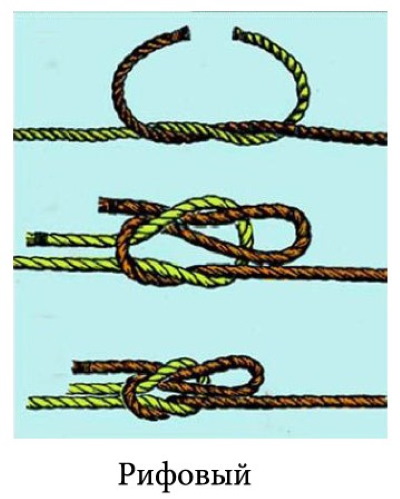
Technique of execution:
- Tie a lower half knot and make a loop similar to the loop of a straight knot.
- The end of the other rope is folded in half and threaded through this loop and tightened.
- You have half a bow. The short ends of the cord should come out on one side and be parallel to each other and to the long part of one of the ropes.
The cords used for the reef knot are non-synthetic, of the same diameter and made of the same material. A knot with 2 half bows is called a double reef knot and is used in everyday life for packing packages, tying laces and bows.
Counter
The second name for the counter conductor is a tape node. Climbers and hikers use it to tie slings and belts. Refers to auxiliary connections, takes a long time to tie. Serves to connect ribbons of the same and different diameters, to tie a rope to a ribbon. The counter knot is reliable, does not slip and holds weight well.
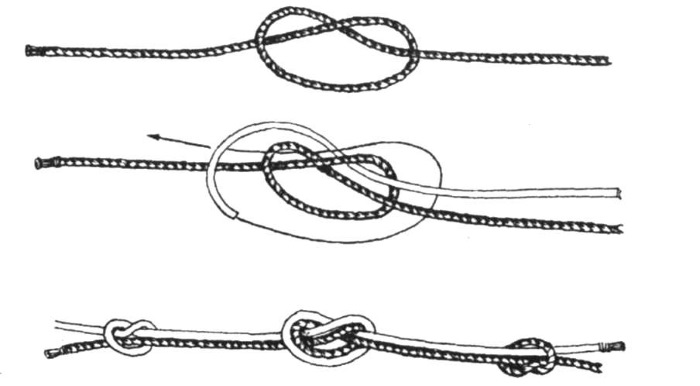
Technique of execution:
- The free ends of the ropes are positioned towards each other.
- The end of one rope is tied with a simple knot and not tightened.
- The second rope is pulled through the knot, moving parallel to the bends of the first rope and not allowing any distortions.
- The ligament is tightened as much as possible.
Control knots are not tied on slings; in other cases, the connection is strengthened. The disadvantage of the counter knot is its ability to tighten so much under serious load that it is impossible to untie it.
Weaving
A strong knot, other names are fisherman's, forest, river. The tourist name is an auxiliary bowline. The weaver's knot is necessarily reinforced with control knots.
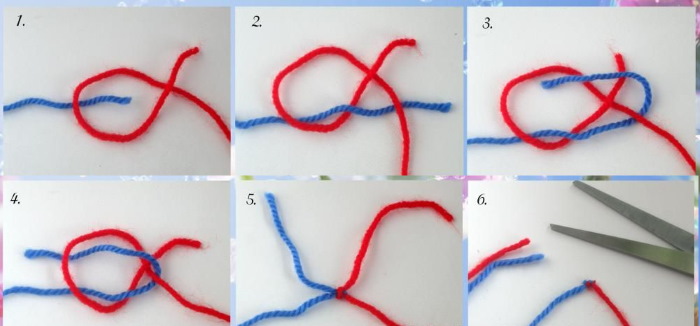
Technique of execution:
- The free end of one cord is tied with a simple knot and the second cord is pulled through it.
- Grab the end of the second cord with the first cord and tie a regular knot.
- The 2 resulting knots are moved and tightened. Control knots are made on the free ends of the ropes.
The advantage of the weaver's knot is that it is easy to tie. Its disadvantages include the ability to slip and tighten strongly under increased loads. Fishermen use the knot to tie fishing lines.
Ropes of different thicknesses
Tourist knots with names, diagrams of which help tourists to connect ropes of different diameters, are used depending on the situation.
Sheet
The knot got its name from the sheet, the tackle used to control the sail. Other names for the knot are Weber's knot, weaver's bowline, net, and bucket. In this way, a taut rope is tied to a carabiner or metal ring. The knot is used when the rope is under constant tension. When the load is weak or variable, the sheet knot slips.
Technique of execution:
- At the end of the thicker rope, a closed loop is tied, with the short end passing over the long part.
- The second rope is inserted into the loop and pulled out, grasping the loop in a circle at the base.
- The short end is crossed with the long end of the rope and pulled through the loop. It turns out that the thin string goes around the base of the loop in a figure eight.
- The knot is tightened and a safety line is tied.
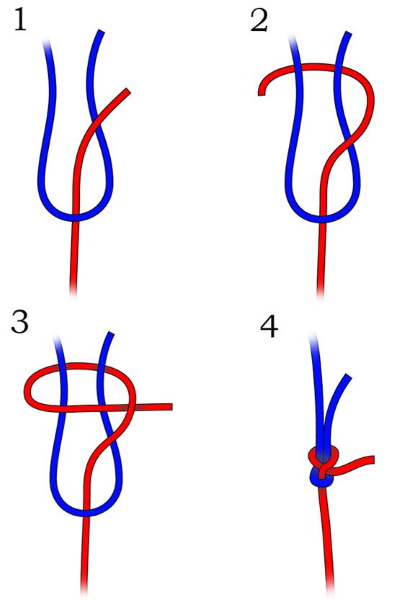
Traditionally, the sheet knot is used to tie ropes of different thicknesses, but it also holds ropes of the same diameter firmly. Under load, it does not tighten or weaken the rope, and is easy to untie. This knot is not used for synthetic ropes because of possible slippage.
Topgallant clew
A reinforced version of the Weber knot, also known as the double sheet knot. It is used in rigging operations, tugboats, when it is necessary to connect with a rigid rope. A topgallant sheet knot is used under constant load, it can withstand jerks and sudden changes in direction of movement.
Technique of execution:
- A closed loop is made from a thick rope.
- The end of the second rope is pulled through it, it goes around the base of the loop and the thin rope is threaded under itself over the loop.
- Once again, go around the base of the loop with the free end and pull it through the passage between the loop and the thin rope.
- The knot is tightened, holding the thick loop, and straightened. Control knots are tied on both sides.
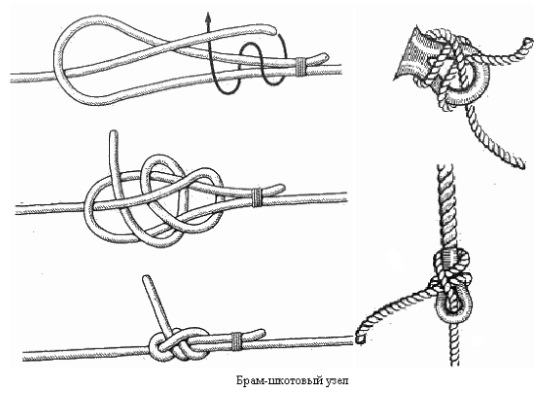
The topgallant sheet knot reliably holds both ropes of different diameters and rigid artificial cables of the same thickness.
Academic
Tourist and sea knots, different in purpose and knitting, received one name - academic. Diagrams and descriptions will help to distinguish them and use them correctly.
The marine academic knot is effective when it is necessary to tie taut rigid cables, or to connect an elastic rope to a rope. It is used for tying bulky and elastic loads. The knot is simple, does not slip, and is easy to untie.
Technique of execution:
- The ends of two ropes are placed one on top of the other and intertwined once, pulled upward.
- The interlacing is repeated, only the rope is twisted in the other direction, towards the turns of the first half-knot.
- The ends of the ropes are tightened. The result is a knot in the form of a pigtail.
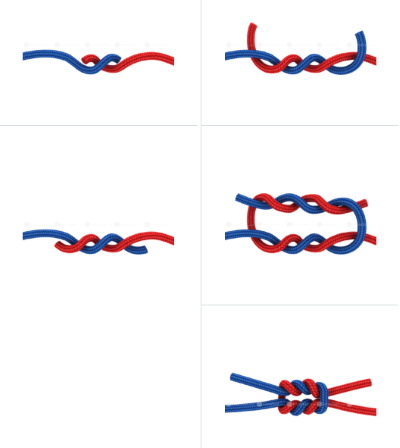
The academic sea knot is used to connect simple and synthetic ropes. Fishermen use it to tie fishing lines.
A more complicated version of the direct knot is the academic tourist knot. Under load, it tightens less and unravels more easily than a straight knot. The knot is effective under constant and variable impact.
Technique of execution:
- A half-loop is formed from a cord of greater thickness.
- The free end of the smaller cord is passed through the loop, wrapped around its base, and the short and long ends of the cord are crossed.
- Pull the short tail of the cord through the loop, tighten, and secure with safety knots.
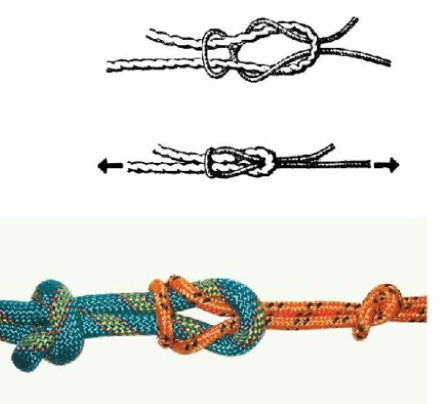
This knot is used to tie a rope to a pole or tree. It is prohibited to use the academic tourist knot during overhead crossings.
Additional knots and loops
Tourist knots with names (diagrams show rope safety and auxiliary connections) are used during descents, ascents, crossings. In this case, tourists use modifications of sea knots.
Conductor
The guide knot is a non-tightening loop knot, simple, tied with one hand. It is made at the beginning or middle of the cable for fixation. Under the influence, the knot tightens strongly and does not slip.
A conductor connects a rope to a carabiner or a metal ring, ties it around a tree or a pole. The knot is used in safety systems to secure rope ladders. If there is a damaged section on the cable, it is isolated by tying a conductor.
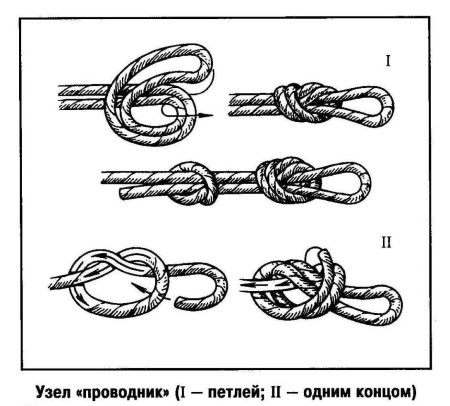
Technique of execution:
- The end of the rope is folded in half to form a loop.
- Pull the double end through the loop and tighten.
- If the fastening is used under variable loads, then a control knot is tied.
The disadvantage of the conductor is that it is difficult to unravel, and works worse in the middle of the cable than at the end.
Dummy knot
An additional knot used to tighten the top of a bag or backpack. The pacifier can be easily untied by pulling the ends of the rope in different directions.
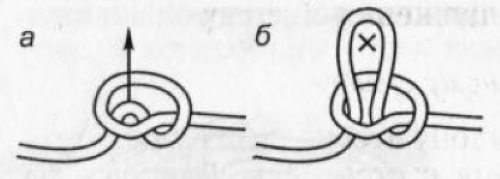
Technique of execution:
- A loop is formed in the middle of the rope.
- One part of the rope is pulled through it, forming a loop-eye.
- Tighten the knot.
The dummy knot is used when tying bowline and double conductor knots.
Marking unit
Another name for the marking knot is the Alpine reel. This is how wires and ropes up to 40 m long are tied when they are rolled into a coil - a multi-layer ring - for transportation and storage. The bundle fixes the end of the cable and prevents the coil from unraveling.
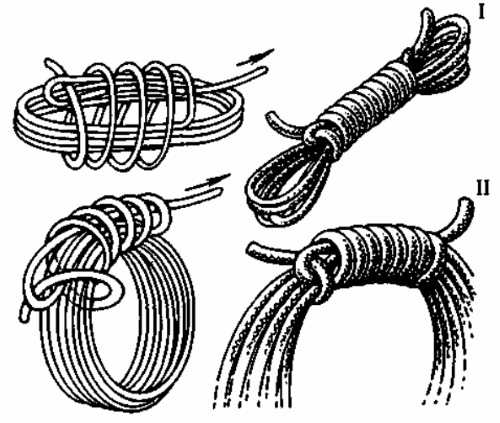
Technique of execution:
- The rope is rolled into a coil, the last turn is made 1/3 shorter than the others.
- A loop is formed at the end of the rope.
- The skein and loop are wrapped tightly with the free end of the rope 5-7 times and pulled through the loop.
- Tighten the knot until it stops.
Tourists use the marker fastener when making stretchers to extend the short wooden parts of the base. Signalmen use an alpine reel to repair a damaged cable.
Bachmann's knot
The Grasping Knot is named after its creator, mountaineer and rescuer Franz Bachmann. Under load, the ligament presses the carabiner against the cable, preventing it from moving. The Brahman knot is used for rescue operations, lifting loads, overhead crossings, and is tied on single and double ropes.

Technique of execution:
- A rope of a smaller thickness is threaded through the carabiner and its long base is applied to the leading cable.
- The rope, folded in half, is passed through the carabiner and screwed to the cable with 3-4 turns.
- Under the action of force, the knot presses the carabiner, preventing it from moving. To resume the movement of the carabiner, the load is released.
The Bachman knot is reliable, does not tighten, and can be used with gloves. The disadvantages of the attachment are that it does not hold an icy rope well, can slip, and for this reason it is practically not used in safety systems.
Austrian conductor
The Austrian conductor is a non-tightening knot, other names are the middle conductor, the riding loop, the alpine moth. It is used to create a reliable loop in climbing harnesses and rope ladders., in fishing and in everyday life. The knot is easy to untie, does not slip, and slightly reduces the strength of the rope.
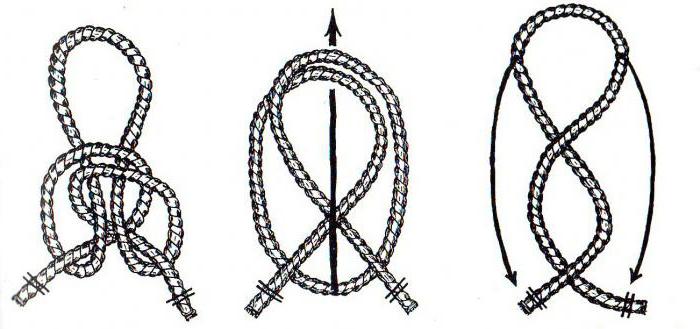
Technique of execution:
- The rope is folded in half into a loop and crossed again to form a figure eight.
- The top loop is lowered down, placed under the intersection of the rope and pulled through to the bottom of the figure eight.
- The loop is adjusted and the knot is tightened in both directions.
Performing a middle conductor requires practice, it is inconvenient to perform it with gloves and one hand. At the end of the rope, experienced tourists recommend tying not an Austrian knot, but a figure-eight loop.
Stirrup
A stirrup, also known as a dandy or clove hitch, is a knot used to attach ropes to supports, carabiners, and other objects with a flat surface. It is used for self-insurance during rescue operations., used as a loop for the foot during the climb. The stirrup knot is used to tie several objects together with one rope.
Technique for performing on support:
- The free end of the rope is wrapped around the pole once, a loop is formed and the end is lowered down.
- At the bottom, another loop is wound onto the support and tightened.
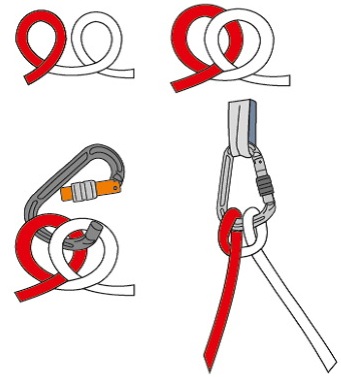
If the rope is synthetic, an additional knot is tied close to the support. When tying the stirrup with one end, a control knot is also necessary.
Technique for performing with one end:
- Pass the rope through a support or carabiner.
- The ropes are crossed to form a loop and another loop is made towards the first one.
- Place the second loop on the support (carabiner). Tighten the stirrup by pulling down both ends of the rope at the same time.
When using the stirrup, it is important to remember that under constant load the knot does not tighten, but under variable application of force it creeps.
Prusik knot
The knot was invented by the Austrian mountaineer Karl Prusik. It is tied with a thin rope (repshinur) on the main rope of a larger diameter. The optimal ratio of rope diameters is 1:2.
Prusik is used when making a tension crossing, for insurance during ascent and descent along a rope. The knot is easy to tie with one hand, holds the load firmly, and moves easily when loosened.

Technique of execution:
- The ends of the cord are tied together to form a loop.
- The loop is wrapped around the main rope and pulled through. This is repeated so that symmetrical turns are formed on the sides of the fastening. Climbers use a knot twisted in 3 turns.
- The prusik is adjusted and tightened. If the cord was not tied with a counter knot, then a check is made.
Disadvantages of the knot: slips on wet and icy surfaces, does not hold on rigid ropes, requires a lot of practice in tying.
Spanish gazebo
The Spanish Bowline (Boatswain's) Knot looks like two loops connected together. The bundle serves as an alternative to a rope cradle during rescue operations. To help the victim, his legs are inserted into two non-tightening loops of the knot, the rope is tied at chest level with a half hitch and the person is raised or lowered.
Technique of execution:
- In the middle of the rope, fold 1 large loop, and on 2 sides of it, fold 1 smaller loop.
- The large loop is folded forward and the 2 side loops are pulled through it.
- The knot is pulled tight.
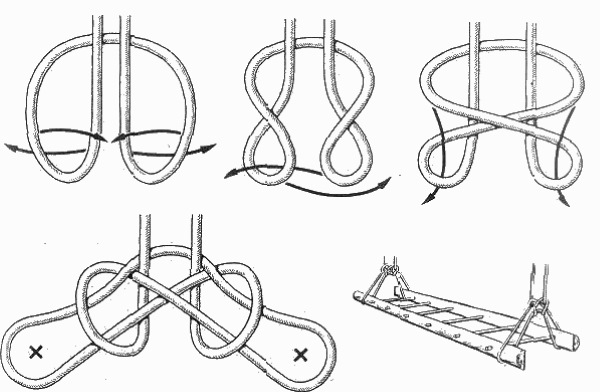
In the navy, a Spanish bowline is used to construct a gazebo for external work. A board is inserted into the knot's loops, on which a sailor sits, and he is lowered overboard or lifted up the mast for painting.
Eight
The figure eight knot is a stopper knot that is quick to perform. It thickens the rope and locks it in place, preventing it from slipping through anchors or holes. Using a figure eight, climbers attach carabiners to a rope, and fishermen tie hooks to a fishing line.
The knot does not untie, shift or tighten on its own. It is used on cables and ropes made of all materials. The figure eight is not suitable only for stiff fluorocarbon lines.
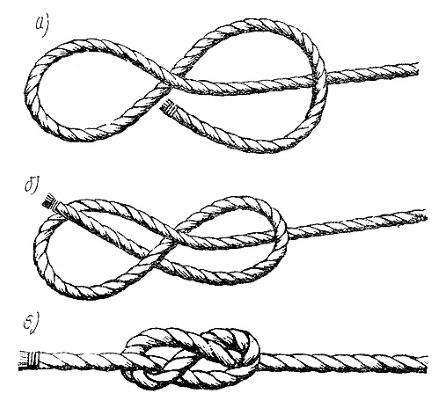
Technique of execution:
- The rope is crossed in the form of a loop so that the long part of the rope is on top of the short one.
- Pull the short end into the loop.
- The knot is tightened.
Other names for the knot are the Savoy knot and the Flemish knot. At least 20 knots, different in purpose, have been developed based on the figure eight. A popular fastening option is the figure eight in the form of a loop. To obtain it, the free end of the rope is folded in half and tied in a traditional knot.
For children
Games with knots develop the child’s imagination, fine motor skills and perseverance.
The cords for classes with a preschooler should be multi-colored, about 50 cm long, of medium thickness and not stiff. You can make a stand according to the child's height, on which you can attach all kinds of ropes. First of all, the child is taught to tie shoe laces, bows and ties on dolls, decorative ties on clothes.
They begin training with a simple knot that is tied with one hand:
- Step back 3 cm from the thumb and hang a rope on the wrist so that its back part is shorter than the front and does not exceed 30 cm.
- They swing their hand with the rope from right to left and try to catch the back end of the cord.
- A loop will form on the palm, and the short end of the rope will be clamped between the index and middle fingers.
- With a sharp movement, shake the rope off your hand, while firmly holding its end with your fingers and trying to pull it into the loop. It takes a preschooler several tries to learn how to tie a simple knot this way.
Next, they learn the guide and straight knot, then more complex ligaments. It is important for the child to see the benefit of the acquired skills, so you need to involve him in tying ropes at home and on vacation, ask him to help when setting up a tent or canopy
How to secure a rope to a base
Tourist knots with names (diagrams of how to tie a rope on a support should be studied by every tourist) are studied before going on a trip. Such bundles are used for ascent and descent, construction of a canopy, during rescue operations.
Bayonet
The non-tightening knot consists of 2 parts - half-bayonets. This is a simple and reliable knot for fastening something on a vertical base and under tension. This is how a rope is tied to a hook for towing a car or boat. The bayonet knot is used to create crossings, rope ladders, stretch awnings, and secure loads.
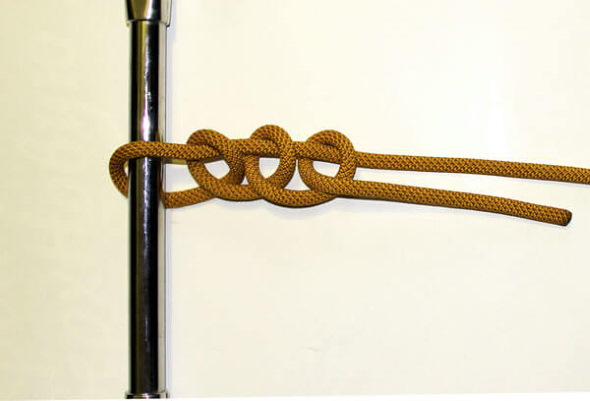
Technique of execution:
- The rope is thrown over the support and a loop is formed.
- The end of the rope is pulled through the loop - this is the first half hitch.
- The short end of the rope is looped on the long end and the half hitch is repeated. It is tied in the same direction as the first. If the second part of the hitch is tied incorrectly, it will tighten.
- The free end of the rope must be secured with a control knot.
The maximum number of half hitches in a knot is 3. It is not recommended to tie a larger number, as this will not increase the strength of the hitch, but will increase the time it takes to tie and untie it.
Bowline loop
A bowline knot is a non-tightening loop at the end of a rope. Sailors consider it the king of knots for its reliability. The bowline is quick to untie and can be tied with one hand, which is important during rescue operations. This knot is used to attach a rope to metal rings, hooks, vertical and horizontal bases.
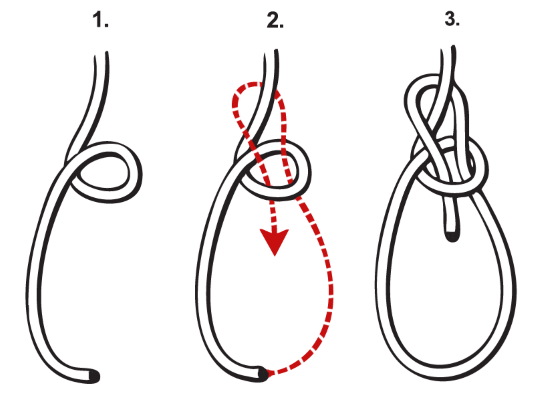
Technique of execution:
- Make a simple loop at the end of the rope or wrap it around the support once.
- Use your fingers to hold the crossing point and pull the free end of the rope through the loop from below.
- They pull the rope through, wrap it around the long part from behind and pass the end through the small loop again.
- Tighten the knot by pulling the large loop and the long part of the rope in different directions.
The bowline must be secured with a control knot. The disadvantages of the king knot are the difficulty of tying and the ability to slip under inconstant loads.
Noose
A practical knot for securing a rope to a base is the Zimmerman noose. It belongs to simple ligaments, is easy to knit and quickly unravels without stress.
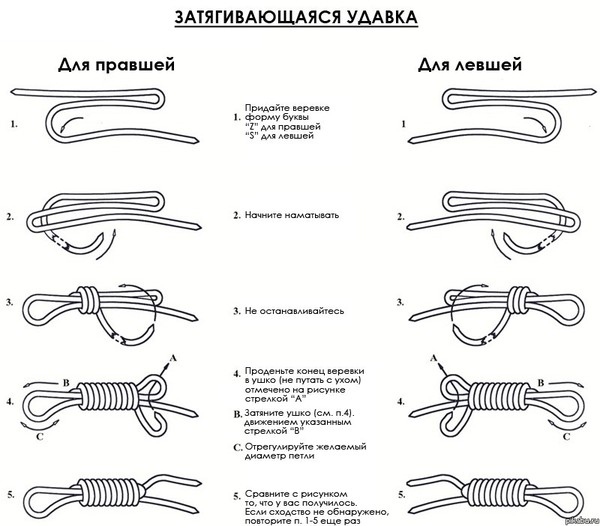
Technique of execution:
- The rope is wrapped around the support and a closed loop is formed.
- Continue moving the rope along the loop, winding it 3-4 times.
- Pass the end of the rope through the loop and pull it tight.
The Zimmerman choke holds tension reliably under constant pressure, but slips under variable load. To prevent this from happening, the knot is secured with 1 or 2 control knots.
Pulling the rope without sagging
A rope stretched between two supports sags under the influence of weather conditions and loads. There is a way to maintain tension without using special devices.
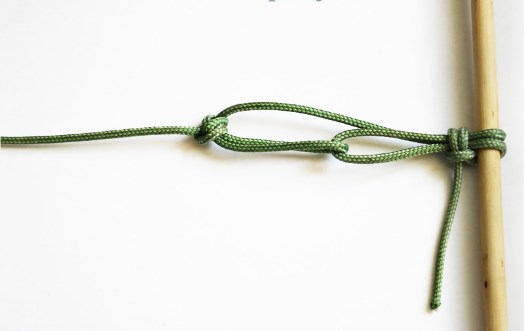
Procedure:
- On one support, tie a rope with any knot that can be quickly untied.
- Make a figure eight loop or other loop knot in the center of the rope and pull the rope through it to create a small loop.
- They wrap the free end around the second support and return to the figure eight loop.
- The free end of the rope is tied to the second loop; the type of knot does not matter.
- The structure is tightened as much as possible; in its finished form it looks like a rope, split in two from the middle.
This method of pulling the rope is suitable for simple situations - drying laundry, fish, ferrying a light load across a stream. The popular name of the method is a pulley block, it comes from the designation of an industrial lifting device.
Improved rope tension
To improve the tension of the stretched rope, experienced tourists use homemade or store-bought clamps. A turnbuckle is a device equipped with rings or hooks at the ends. It is used to tighten loads and cables in production. Such a device will also come in handy on a hike.
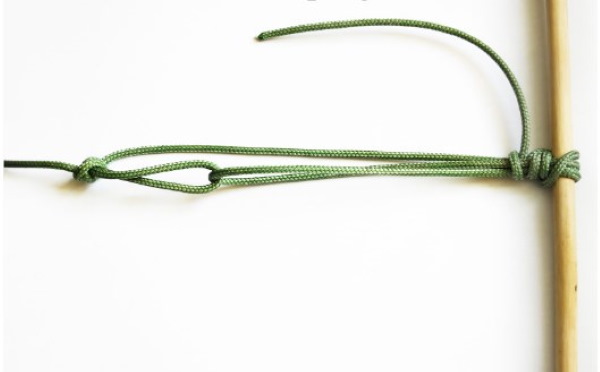
One side of the turnbuckle is attached to the support in a rigid manner, using a hook, dowel or anchor. On the other side, the rope is tied with a self-tightening knot or loop. To increase the tension, the turnbuckle is rotated around its axis. If you rotate the device in the other direction, the rope is weakened.
Another option for keeping the rope taut is to use a pulley block. One end of the rope is firmly attached to the support, and the other is passed through the block. A weight is tied to the roller, which serves as a counterweight and prevents the rope from sagging.
The science of nausistics studies knots of various purposes. And in the 21st century, specialists improve their tying patterns, clarify their names, and invent new tourist, mountaineering, and speleological ligaments.
Article formatting: Natalie Podolskaya
Video about tourist hubs
What are tourist knots, their names, patterns and how to tie them - in this video:
https://www.youtube.com/watch?v=Ls4MEJCyB6s

Is there a special application about nodes for Android OS?
A wonderful, time-tested technique of tying knots, necessary for hiking and carrying things, tying body parts firmly and securely. And also the necessary technique of tying knots is necessary in all respects for the use of the rope and chain itself.